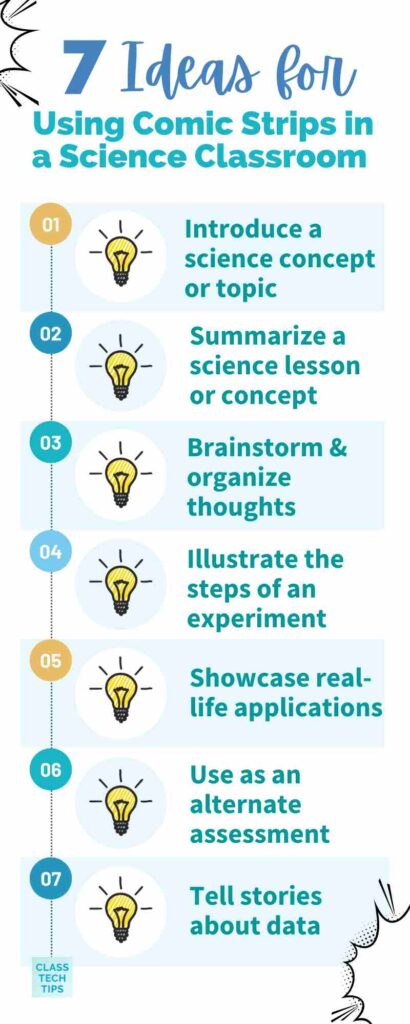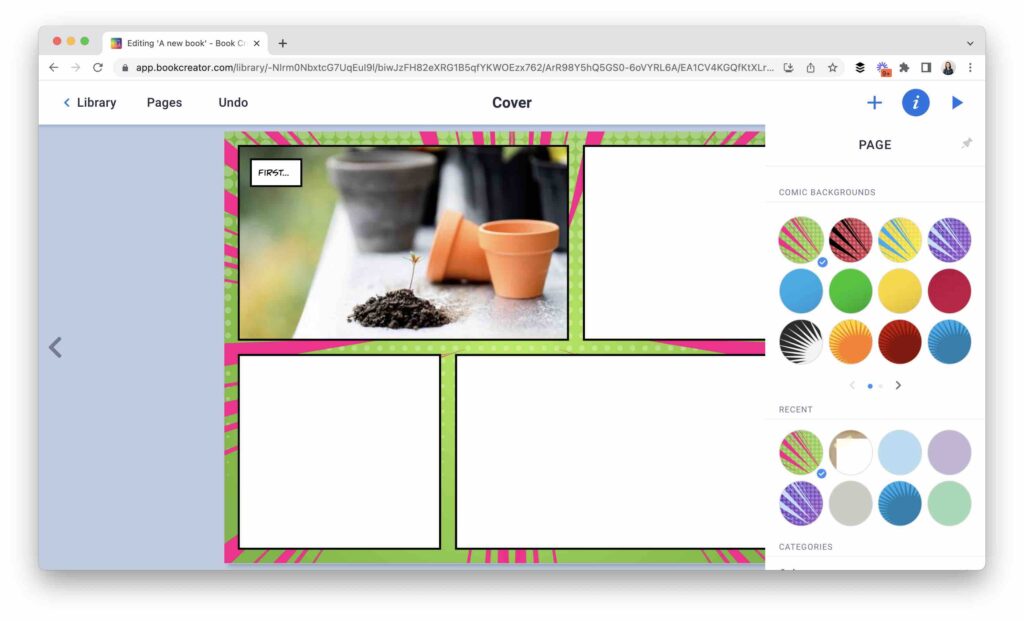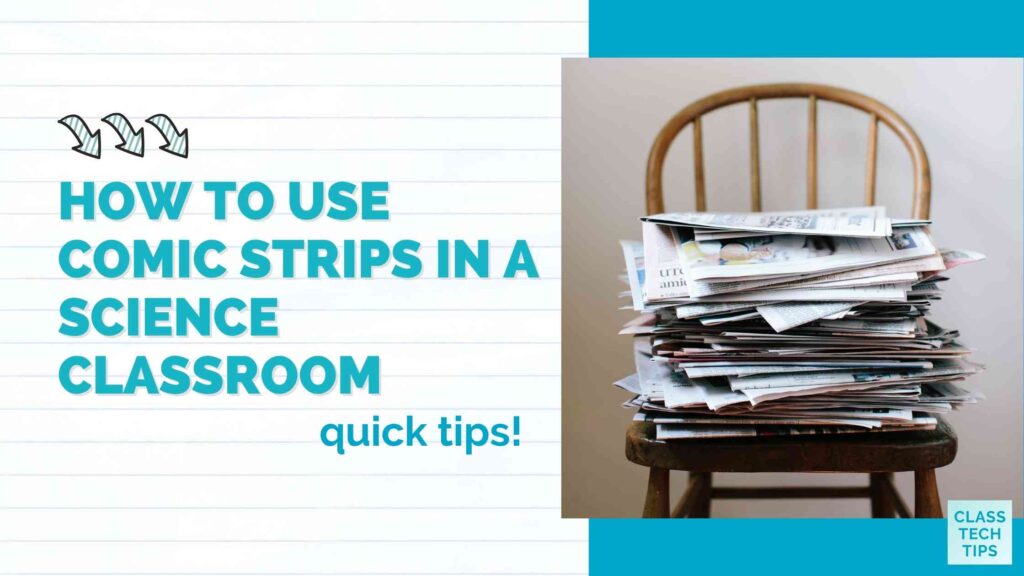Comic strips are a fun and engaging way to introduce complex concepts to students. Not only can they provide a visual representation of an idea, but they also allow for a creative outlet for students to express their understanding of the material. Using comics in education settings provides students with a creative way to apply what they have learned about science topics.
Regular readers of the blog know that I’m a big fan of comic strips. You might remember this blog post, “5 Reasons to Try a Comic Strips Activity,” from last year. Or you may have listened to this episode of the Easy EdTech Podcast, titled “Liven Up Your Lesson with a Comic Strip Twist.”
In this blog post, we will discuss how teachers can use comic strips in their science classrooms to enhance student learning and engagement!
Note: Don’t forget to download these free templates I’ve made for your next comic strip-inspired project.
Benefits of Using Comics in Education
Using comics in education settings, specifically in the science classroom, can have several benefits. Comic strips can provide a fun and engaging way for students to summarize science concepts. This might connect to the types of materials students read themselves, like graphic novels.

Comic strips can also serve as a valuable tool for visual learners. This medium can help them to visualize and retain scientific information. You can also use comic strips to promote creativity and critical thinking in the science classroom. Students need to make decisions and think about how best to represent scientific ideas and processes through visual storytelling.
You might also use comic strips to facilitate group discussions and collaboration. For example, kids can examine comic strips together and talk about what they see, or they can work together to create their own and build upon each other’s ideas.
7 Ideas for incorporating comic strips into your next science activity
Here are seven activity ideas where you can incorporate comic strips into your science classroom!

Introduce a science concept or topic
Use comic strips to introduce a science concept or topic. You might find or create a comic strip to share or have students explore comics created by a partner class. Alternatively, you could ask students to create a comic strip at the end of one unit of study and then save copies to share with next year’s group of students.
Summarize a science lesson or concept
Create a comic strip to summarize a science lesson or concept. After students have explored a new topic, ask them to create a comic strip to summarize what they have learned. This could include two characters, where one explains the concept to another.
Create graphic organizers
Use comic strips as a graphic organizer to help students brainstorm and organize their thoughts on a science topic. Instead of storytelling, students can use the comic strip format to organize ideas into cells. For example, this could be a way for students to combine an illustration or image with a short text description of the topic.
Illustrate a process
Illustrate the steps of a science experiment or procedure. To have students prepare for a science experiment or debrief after they finish, they can create a comic strip to show the steps. If using this beforehand, you might incorporate creations on lab safety. If using this afterward, you might ask students to reflect on what they would do differently.
Spotlight applications
Showcase real-life applications of science concepts. Students can use a comic strip to tell a story that shows off an application of science concepts outside the classroom. Your students might also spotlight a science career or incorporate an interview with someone who conducts this type of work.
Don’t forget to download my comic strip templates, you can click here to grab them for free.
Leverage alternative assessments
Comic strips as an alternate assessment. To evaluate students’ understanding of a science concept, you might include a creative option. Instead of, or in addition to, a traditional assessment, using comics in education can also give you a window into student understanding.
Tell stories about data
Use comic strips to tell stories about data. To present scientific data or findings in a visually appealing and engaging way, you might have students use a comic strip. I’m a big fan of infographics, but a comic strip is another option for representing data. If students conduct an experiment or research where data is essential, this is another creative way to share that information.

Tools for creating comic strips
There are a handful of great tools to help you create comics in your classroom. I’ve worked with the Book Creator team to create a few different learning resources, and I am a big fan of the comic option within this tool. Students can choose the comic option when they go to create a new book to access all of the comic book features.
Another tool for creating comics is StoryboardThat. This tool lets you combine characters and settings to tell a story. Students can use this tool to create their own comic using one of the project ideas on the list above.

If you’re a member of my Easy EdTech Club, you might remember how I shared the steps for creating comics using Book Creator and Keynote. In addition to Keynote, your students can create comic strips by combining shapes in Google Slides. You might find that a tool already in your student’s tool belt is the right choice for this type of project.
Incorporating comic strips into the science classroom can be a fun and effective way to engage students and deepen their understanding of scientific concepts. By following the tips and ideas outlined in this blog post, teachers can easily integrate comic strips into their lesson plans and create a more dynamic and interactive learning environment for their students.
Note: This blog post was written with some help from ChatGPT for inspiration and assistance with the writing process. This tool has been in the news, and I’m trying it out to learn more about it and the role of Artificial Intelligence (AI) in education.
Find more posts on Comic Strips:
- 5 Quick Classroom Activities With Comics
- Liven Up Your Lesson with a Comic Strip Twist – Easy EdTech Podcast 169
- How to Create a Comic Strip in Google Slides
- 15 Ready-To-Use Comic Strip Templates for Your Next Lesson
- 5 Reasons to Try a Comic Strips Activity
- Using Graphic Novels to Teach High-Level Thinking with Shveta Miller – Easy EdTech Podcast 152







